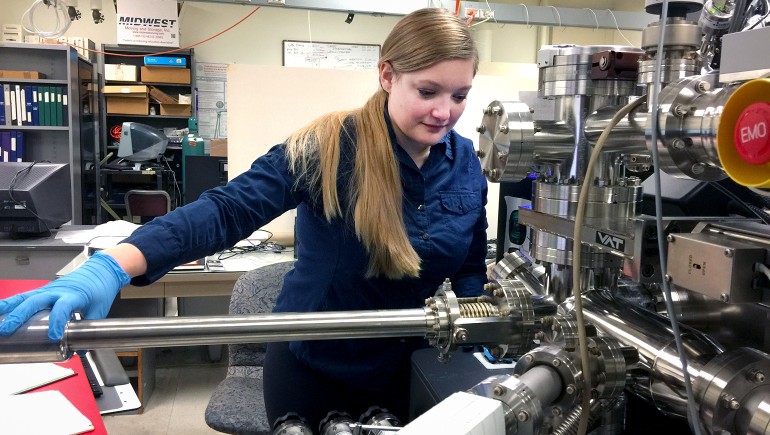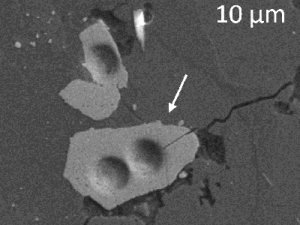
The moon is 40 million years older than we thought
The leading theory on the formation of the moon is that – in the early years of our solar system – a Mars-sized object smashed into the young Earth! During this giant impact, either a chunk of the impactor, or debris kicked up from Earth, then coalesced to form our moon. Scientists thought this big collision happened about 4.425 billion years ago. But Northwestern University said on Monday (October 23, 2023) that new analysis of crystals inside lunar rocks, brought back by the Apollo missions, place this date 40 million years earlier. This new info places the birth of the moon at around 4.46 billion years ago. So the moon is older than we thought.
Dieter Isheim, co-author of the study from Northwestern University, commented:
This study is a testament to immense technological progress we have made since 1972 when the last manned moon mission returned to Earth. These samples were brought to Earth half-a-century ago. But only today do we have the necessary tools to perform microanalysis at the requisite level…
The researchers published their peer-reviewed study in the journal Geochemical Perspectives Letters on October 23, 2023.
Dating zircon crystals
Zircon is also a commonly occurring mineral in Earth’s crust. And scientists can date the age of zircon. In fact, zircon crystals from western Australia have yielded ages up to 4.404 billion years, which makes them the oldest minerals yet dated on Earth.
And we’ve also found zircon in minuscule crystals from lunar samples. An international team of researchers from Chicago’s Field Museum and the University of Glasgow used Northwestern University’s atom-probe tomography facility to study these crystals. Thus they were able to pin down the age of the lunar sample.
The 2024 lunar calendars are here! Best Christmas gifts in the universe! Check ’em out here.

How radioactive dating works
Northwestern’s atom-probe tomography gave the researchers a close look at the atoms of zircon. This view helped them pinpoint the date. As the press release explained:
The atom-by-atom analysis enabled researchers to count how many atoms in the zircon crystals have undergone radioactive decay. When an atom undergoes decay, it sheds protons and neutrons to transform into different elements. Uranium, for example, decays into lead. Because scientists have established how long it takes for this process to unfold, they can assess the age of a sample by looking at the proportion of uranium and lead atoms.
Philipp Heck of the Field Museum provided another description of how the dating works:
Radiometric dating works a little bit like an hourglass. In an hourglass, sand flows from one glass bulb to another, with the passage of time indicated by the accumulation of sand in the lower bulb. Radiometric dating works similarly by counting the number of parent atoms and the number of daughter atoms they have transformed to. The passage of time can then be calculated because the transformation rate is known.
How zircon formed on the moon
Lead author Jennika Greer of the University of Glasgow explained at what point the zircon crystals formed on the newborn moon after the giant impact with Earth:
When the surface was molten like that, zircon crystals couldn’t form and survive. So, any crystals on the moon’s surface must have formed after this lunar magma ocean cooled. Otherwise, they would have been melted and their chemical signatures would be erased.
Thus, if the crystals formed after the magma oceans on the moon cooled, the zircon crystals reveal the minimum possible age of the moon. So, using the tomography technology, they dated the oldest crystals in the samples. And that led them to the conclusion that the moon could not be younger than 4.46 billion years old.

Why do we care?
So, the moon is 40 million years older than scientists once thought. It was thought to be 4.425 billion years old. Now the moon is thought to be 4.46 billion years old. Why do scientists care? They care because they are curious people. And each bit of new information is a clue added to the puzzle of our solar system, our Earth and our place in the universe. As Heck explained:
The moon … stabilizes the Earth’s rotational axis. It’s the reason there are 24 hours in a day. It’s the reason we have tides. Without the moon, life on Earth would look different.
It’s a part of our natural system that we want to better understand, and our study provides a tiny puzzle piece in that whole picture.
Bottom line: Researchers studied zircon crystals in lunar samples brought back by Apollo astronauts to determine the moon is 40 million years older than we thought.
Source: 4.46 Ga zircons anchor chronology of lunar magma ocean











